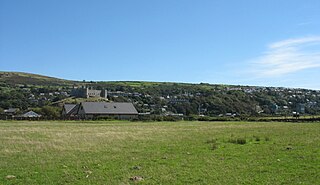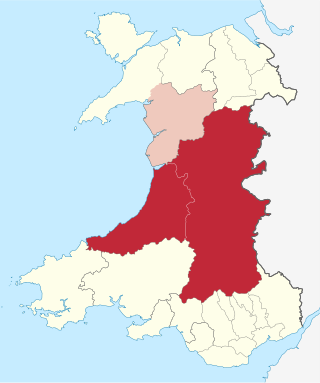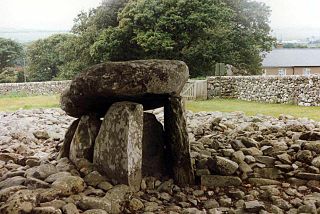Related Research Articles

Snowdonia, or Eryri, is a mountainous region and national park in North Wales. It contains all 15 mountains in Wales over 3000 feet high, including the country's highest, Snowdon, which is 1,085 metres (3,560 ft) tall. These peaks are all part of the Snowdon, Glyderau, and Carneddau ranges in the north of the region. The shorter Moelwynion and Moel Hebog ranges lie immediately to the south.

Harlech is a seaside resort and community in Gwynedd, north Wales and formerly in the historic county of Merionethshire. It lies on Tremadog Bay in the Snowdonia National Park. Before 1966, it belonged to the Meirionydd District of the 1974 County of Gwynedd. Its landmark Harlech Castle was begun in 1283 by Edward I of England, captured by Owain Glyndŵr, and in the 1480s, a stronghold of Henry Tudor. Once on a seaside cliff face, it is now half a mile inland. New housing has appeared in the low town and in the high town around the shopping street, church and castle. The two are linked by a steep road called "Twtil". Of its 1,447 inhabitants, 51 per cent habitually speak Welsh. The built-up area with Llanfair had a population of 1,762 in the 2001 census, over half of whom lacked Welsh identity, and the electoral ward which includes Talsarnau 1,997 in the 2011 census. The estimate in 2019 was 1,881. The population of the community, which includes just the village, was 1,263 as of the 2021 census.

The Rhinogydd are a range of mountains located east of Harlech in North Wales. The name Rhinogydd derives from the names of two of the more famous peaks, Rhinog Fawr and Rhinog Fach, although the greatest elevation in the range is reached by Y Llethr, 756 m.

Mid Wales or Central Wales is a region of Wales, encompassing its midlands, in-between North Wales and South Wales. The Mid Wales Regional Committee of the Senedd covered the unitary authority areas of Ceredigion and Powys and the area of Gwynedd that had previously been the district of Meirionnydd. A similar definition is used by the BBC. The Wales Spatial Plan defines a region known as "Central Wales" which covers Ceredigion and Powys.

The Afon Mawddach is a river in Gwynedd, Wales, which has its source in a wide area SH820300 north of Dduallt in Snowdonia. It is 28 miles (45 km) in length, and is much branched; many of the significant tributaries are of a similar size to the main river. The catchment area is bounded to the east by the Aran Fawddwy massif and to the west and north by the Harlech dome which forms a watershed just south of Llyn Trawsfynydd.

The Cambrian Line, sometimes split into the Cambrian Main Line and Cambrian Coast Line for its branches, is a railway line that runs from Shrewsbury, England, westwards to Aberystwyth and Pwllheli in Wales. Passenger train services are operated by Transport for Wales Rail between the western terminals of Pwllheli, in Gwynedd, and Aberystwyth, in Ceredigion, and the eastern terminal at Shrewsbury, Shropshire, as part of the Wales & Borders franchise. The railway line is widely regarded as scenic, as it passes through the Cambrian Mountains in central Wales, and along the coast of Cardigan Bay in Snowdonia National Park.

Harlech railway station is located at a level crossing on the A496 in the centre of the town of Harlech in Gwynedd, North Wales. The waiting shelters were installed to cater for the high numbers of schoolchildren commuting to and from the adjacent secondary school, Ysgol Ardudwy.

Barmouth railway station serves the seaside town of Barmouth in Gwynedd, Wales. The station is on the Cambrian Coast Railway with passenger services to Harlech, Porthmadog, Pwllheli, Tywyn, Aberdovey, Machynlleth and Shrewsbury. Between Morfa Mawddach and Barmouth the railway crosses the Afon Mawddach on the Barmouth Bridge.

The Solitario is a large geologic formation in Big Bend Ranch State Park in West Texas. When viewed from above, it suggests an impact crater; though it is actually the eroded remains of a laccolith. The approximate center of the Solitario is located 56.8 km (35.3 mi) east southeast of Presidio, Texas, just west of the line dividing Brewster County, Texas and Presidio County, Texas. The formation covers a circular area of approximately 135 km2 (52 sq mi). The geology of the Solitario is complex. In 1988, the state of Texas purchased the property containing the Solitario and created Big Bend Ranch State Park.

The geology of Wales is complex and varied; its study has been of considerable historical significance in the development of geology as a science. All geological periods from the Cryogenian to the Jurassic are represented at outcrop, whilst younger sedimentary rocks occur beneath the seas immediately off the Welsh coast. The effects of two mountain-building episodes have left their mark in the faulting and folding of much of the Palaeozoic rock sequence. Superficial deposits and landforms created during the present Quaternary period by water and ice are also plentiful and contribute to a remarkably diverse landscape of mountains, hills and coastal plains.

The geology of Tasmania is complex, with the world's biggest exposure of diabase, or dolerite. The rock record contains representatives of each period of the Neoproterozoic, Paleozoic, Mesozoic and Cenozoic eras. It is one of the few southern hemisphere areas that were glaciated during the Pleistocene with glacial landforms in the higher parts. The west coast region hosts significant mineralisation and numerous active and historic mines.

Dyffryn Ardudwy is a village, community and electoral ward in the Ardudwy area of Gwynedd, Wales. It comprises several small, almost conjoined, villages including Coed Ystumgwern, Llanenddwyn, Llanddwywe, Talybont and Dyffryn Ardudwy. It is situated on the main A496 coast road between Harlech and Barmouth. The ward had a population of 1,540 according to the 2011 census.
Geologically the Australian state of New South Wales consists of seven main regions: Lachlan Fold Belt, the Hunter-Bowen Orogeny or New England Orogen (NEO), the Delamerian Orogeny, the Clarence Moreton Basin, the Great Artesian Basin, the Sydney Basin, and the Murray Basin.

The Harlech Grits Group is a lower to middle Cambrian lithostratigraphic group in northwest Wales. The name is derived from the town of Harlech in Gwynedd.

The Mawddach Group is a middle to upper Cambrian lithostratigraphic group in Gwynedd, Wales. The name is derived from the river known as the Afon Mawddach.
The Cymru Terrane is one of five inferred fault bounded terranes that make up the basement rocks of the southern United Kingdom. The other notable geological terranes are the Charnwood Terrane, Fenland Terrane, Wrekin Terrane and the Monian Composite Terrane. In this article the definition of terrane is that implying rocks associated with the composition of the Precambrian basement. The Cymru Terrane is bounded to the northwest by the Menai Strait Fault System and to the southeast by the Pontesford Lineament. The geological terrane to the west is the Monian Composite Terrane and to the east is Wrekin Terrane. The majority of rocks in the area are associated with the outcrops that are evident at the faulted boundaries.

Mynydd Nodol is a 539m high hill in Snowdonia National Park and lying within the community of Llanycil in the county of Gwynedd in North Wales. It rises above the southern shores of the reservoir Llyn Celyn about 4 km northeast of its higher neighbour Arenig Fawr. Mynydd Nodol forms the backdrop in views from the A4212 car park by the dam. The hill throws down a broad shoulder to the east.

The geology of Ghana is primarily very ancient crystalline basement rock, volcanic belts and sedimentary basins, affected by periods of igneous activity and two major orogeny mountain building events. Aside from modern sediments and some rocks formed within the past 541 million years of the Phanerozoic Eon, along the coast, many of the rocks in Ghana formed close to one billion years ago or older leading to five different types of gold deposit formation, which gave the region its former name Gold Coast.

The geology of Namibia encompasses rocks of Paleoproterozoic, Mesoproterozoic and Neoproterozoic and Paleozoic to Cenozoic age. About 46% of the countryʼs surface are bedrock exposure, while the remainder is covered by the young overburden sediments of the Kalahari and Namib deserts.

The geology of Snowdonia National Park in North Wales is dominated by sedimentary and volcanic rocks from the Cambrian and Ordovician periods with intrusions of Ordovician and Silurian age. There are Silurian and Cenozoic sedimentary rocks on the park's margins. The succession was intensely faulted and folded during the Caledonian Orogeny. The region was uplifted as the North Atlantic Ocean opened during the Cenozoic. The current mountainous landscape arises from repeated glaciations during the Quaternary period.
References
- ↑ "Rhinogydd". The Snowdonial. Archived from the original on 29 November 2014. Retrieved 16 November 2014.
- 1 2 3 4 "Mineral Reconnaissance Programme Report No 74 - "A reconnaissance geochemical drainage survey of the Harlech Dome, North Wales" (1985 PDF - mineralogical report, 113pp)]". British Geological Survey, Natural Environment Research Council. Retrieved 14 November 2014.
- ↑ "Cambrian rocks in Wales". Countryside Council for Wales. Archived from the original on 29 November 2014. Retrieved 14 November 2014.
- 1 2 3 4 "Mineral exploration in the Harlech Dome, North Wales". NERC Open Resesarch Archive. Retrieved 16 November 2014.
- ↑ "Geology - Harlech Dome". Merioneth Manganese. Retrieved 16 November 2014.
- ↑ "The Geology of the Barmouth and Arthog area". Bernard O’Connor. Retrieved 16 November 2014.
- ↑ "Chasing ancient microcontinents in North Wales - the Megumia project". Geology Wales. Retrieved 16 November 2014.
52°52′N3°55′W / 52.86°N 3.91°W